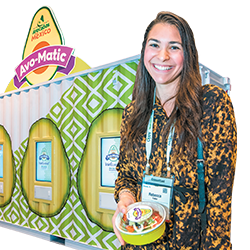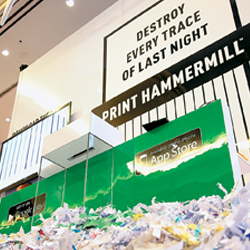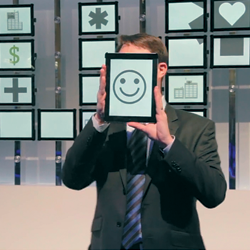| ALL STAR |
 Tina Kruse, is the global exhibitions and events manager for FMC Technologies Inc., where she has worked for more than 14 years. Her marketing-communications responsibilities include: Web, interactive media, collateral, advertising, and trade shows. In her current role, Kruse is responsible for the overall design and development of exhibitions by establishing consistency in standards/guidelines for global implementation and ensuring collaboration within various business units. Tina Kruse, is the global exhibitions and events manager for FMC Technologies Inc., where she has worked for more than 14 years. Her marketing-communications responsibilities include: Web, interactive media, collateral, advertising, and trade shows. In her current role, Kruse is responsible for the overall design and development of exhibitions by establishing consistency in standards/guidelines for global implementation and ensuring collaboration within various business units.
|

very feat of innovation starts off as nothing more than the flicker of a bright idea that might help to solve an ordinary problem. Granted, some flashes of brilliance are better than others, with the best of them exploding into corporate constellations of global proportions. Consider, for example, John Bean. The year was 1884, and he was riled because the crop from his fledgling almond orchard was being thwarted by insects. Bean, a retired inventor, took to his workshop and emerged with a continuous-action spray pump that made administering insecticide a cinch. His crop flourished, and his neighbors clamored for one of his newfangled pumps. In that moment, the seed of FMC Technologies Inc. was planted, but not even Bean could have imagined the eventual magnitude of what he had created.
Bean's empire, called the Food, Machinery, and Chemical Corp. early on, surpassed a billion dollars' worth of sales in 1966, having diversified into numerous, scantly related industries. Acquisitions, spinoffs, and expansions continued until the company split off FMC Technologies Inc. into its own incarnation in 2001, to serve all things energy related, particularly in the oil and gas industries. By 2012, FMC Technologies was earning more than a billion dollars on just one contract. Today, with nearly 20,000 employees scattered in 16 countries and 30 production facilities across the planet, the company is a global provider of equipment and services for the energy industry.

But exponential growth is not without its problems. Under the shingle of FMC Technologies, nine business units served distinct niches of the industry, some working with subsea products while others featured land-based equipment. Proliferate growth continued after the split, and divisions expanded faster than the corporate team overseeing them. This left each business unit to implement its own marketing strategy and create an exhibit program, and the result was somewhat chaotic.
Staffers from one division stumbled across other business units exhibiting at the same show, few groups were using the same logo, and no one knew what anyone else was doing. It was as if there were nine small companies doing business instead of one large one, and the result was confusion, both in the industry and within the company itself.
Facing Facts
As a marketing communications manager in a subsea division, Tina Kruse was struck by the corporate chaos. "I was frustrated with how different we looked even in the subsea group," Kruse says. "There were times when we had different logos being used, sometimes even within the booth at the same time. And the fact that FMC could be at the same show with two different divisions that didn't even know the other was there was disorienting for our customers." Kruse doesn't think any of the directors in various units were to blame. Rather, the problem stemmed from the fact that the company had grown so fast that no one had yet gotten their arms around communication and brand governance across all the divisions. Each unit was just doing its job.
Kruse brought her concerns to the newly hired corporate director of communications and pitched her vision of cohesiveness and marketing efficiency between business units. The communications director liked what she heard – so much so that she created a position to oversee that effort and transitioned Kruse into the new role.
When Kruse stepped into the position of global exhibitions and events manager in January 2013, the company, as best as she could tell, was exhibiting at about 75 different shows a year all over the globe, sometimes with multiple divisions at the same show, and with branding that was all over the map. The very first order of business, she says, was to find out who was organizing those exhibits so she could get everyone aboard the unification train.
Thirty people were responsible for planning exhibits for business units in various regions, Kruse learned, and she approached each with the same promise; "If we work together, we could exponentially cut our exhibiting costs." Because every unit operated with its own financials, Kruse did not encounter push back from any division. Now, Kruse needed to identify other issues plaguing the company's broad exhibit program so she could understand what kind of fix would be meaningful. Soon, Kruse found that there were several less obvious but equally problematic issues at hand. One area of tumult among business units was what responsibility each had when it came to exhibiting with product models. In the oil and gas industry, Kruse says, a scale model of a piece of equipment can easily run 7 feet long by 3 feet high, and units were having models created and shipped all over the world. But the models often broke in transit, shipping alone could cost as much as the rest of the exhibit, and planners sometimes believed that the corporate marketing budget, not their unit, would be absorbing the costs.
Another issue was the inconsistent and apparently unregulated use of the FMC logo by suppliers and distributors that wanted to align their exhibiting presence with the global giant. "Sometimes I would see our logo displayed so prominently on an exhibit that it looked like we had another booth at the show," Kruse says, noting that often it wasn't even the most current logo. For a company trying to straighten out its brand image, this would never do. Lastly, FMC Technologies had not done a good job of characterizing the company as a whole in an exhibiting environment, illustrating its massive capabilities and all its many moving parts. So Kruse needed a way to paint the big picture for attendees, which felt like the most Herculean challenge of all.
 Global Trade
Global Trade
One of Kruse's first steps was to coordinate exhibiting schedules by creating a Web-based global trade show database. Each exhibit manager could access it to add shows he or she would be attending and see what the exhibiting plans were across divisions. FMC adopted a company-wide policy mandating that at any shows where multiple business units wanted to attend, all divisions would join together in one exhibit. To simplify planning, a lead business unit was identified at each show, and that's who managers needed to collaborate with to arrange space for their unit in the display. Exhibit planners could indicate how many square feet they would need, and the costs for the booth would be divided equitably among participating units. Then Kruse set up an alert system that sent emails to all involved parties when changes or updates were made to the schedule.
In a move that All-Star Awards judges hailed as brilliant, Kruse added a communication platform in conjunction with the trade show database, where exhibit managers could post information about upcoming shows, review photos and company guidelines, and interact with the other individuals doing their same job in different units. "It was very impressive how the infrastructure issues were addressed as a first step before moving to an implementation phase," one judge said. "She showed excellent strategic planning and knowledge of internal and external audiences."
Next, Kruse tackled the company's brand guidelines, providing set standards aimed at unifying the company under a single logo and set of exhibiting rules. The exhaustive document outlined everything from the responsibilities of the lead business unit at a show to appropriate color palettes and corporate biography statements. Included in those newly articulated brand guidelines were clear rules for use of the FMC brand by suppliers and distributors, down to which Pantone colors should be used and how the logo could be displayed.
Identity Crisis
In terms of its exhibiting identity, the company needed to go a step further than fonts and Pantone colors, Kruse believed. It required a look – one that could visually tie the company together at trade shows around the world and be modified for spaces that ranged from 100 to 5,000 square feet.
With so many separate units and programs, Kruse knew the needs of each would be diverse, and divisions would be best able to cope if they were given a design concept and allowed to implement it in the way that worked best for them. For some, Kruse says, that would be done by having an exhibit house create build-and-burn booths its emulating the approved design, while others might opt for longer-use exhibit properties.
Initially, Kruse reached out to exhibit houses in search of a company to create a model exhibit. The property she planned to have it build would be for the 2013 Offshore Technology Conference, where FMC would have one of the company's largest exhibits and all nine business units participating. But the proposals Kruse received for the project did not impress her. "I thought the proposed exhibits looked just like everyone else's on the show floor, and I didn't want that," she says.
Then a colleague in Norway planted an interesting idea in Kruse's head. Why not enlist an architect instead of an exhibit house? The architectural firm he had in mind was Snohetta, a Norwegian company known around the world for visual artistry in construction. "I was hesitant because Snohetta is not a trade show architect," Kruse says. "Some of the things the firm creates take years to construct, but in the trade show world, I have seven days to erect the Taj Mahal." Still, Kruse found Snohetta's design aesthetic to be fresh and dynamic, so she took a leap of faith and contracted with the company for what was likely the first trade show booth it had ever designed.

Creating the design took a year, but the resulting exhibit incorporated signature design elements that could be interpreted for booths of any size. FMC, which categorizes its trade shows according to size (tier 1, tier 2, and tier 3 shows), prepared to unveil the prototype exhibit at OTC, a tier 1 show, but Kruse had additional concepts drawn up that would be suitable for various display sizes and smaller configurations.
Kruse uploaded schematics for the design concepts to the trade show document library, as well as photos that exhibit managers could share with their respective exhibit houses. She also added a document with newly created shipping guidelines that would put to rest any questions about transportation protocols and responsibilities, particularly when shipping models to trade shows.
Show and Tell
The last challenge that remained was to conceive a plan that would help FMC illustrate the breadth and depth of its product lines. Kruse decided the best way to deliver a message about its range of products was to create a panoramic mural depicting a slice of Earth showing both ocean-floor and above-ground terrain. The vignette depicted products being used in various operations on land and under water, giving the viewer the impression that FMC had a vast array of broad-reaching capabilities.
It sounded like a simple idea, but this would be no ordinary mural. Kruse contracted a software company to draft a custom program that transformed a 15-by-4-foot panel of screens into an interactive image illustrating FMC products on the sea floor as well as on ships and on land surrounding the sea. The image was embedded with 30 hot spots that, when touched, opened a menu offering details about a product or technology. Users could also view 3-D models of the equipment and other informational resources to learn about the products, including photos, illustrations, and animations. Thanks to its panoramic size, at least 10 attendees could interact with the mural simultaneously, and drag the hot spots around with their fingers to share or compare. Rather than being static images, the graphics were in constant motion: The water glistened, helicopters flew overhead, and sunlight filtered down to the seafloor. In addition to taking in the captivating imagery, users could view products from all nine business units, seeing for the first time the true scope and scale of the company.
While the mural was a show stopper, its expansive width wasn't a practical feature for many of FMC's trade shows. So Kruse had the software structured to be scalable, able to be displayed on a panoramic wide screen or in smaller settings on a touchscreen monitor or an iPad. All nine divisions shared in the cost for the software, and the program was added to the trade show library online for any to download and use.
The Tie That Binds
By creating a master trade show schedule, new guidelines, and a communal Web library, Kruse brought order to a disjointed system, and by making exhibiting resources available to all in one place, she created a streamlined flow of information that has revolutionized the way that FMC does business. Just having centralized communication for the exhibiting programs eliminated approximately 50 emails a day, Kruse estimates, which added untold wealth in the company's planning efficiency.
The financial savings she has achieved, however, are more tangible. Within three months of streamlining duplicated exhibiting efforts, FMC reduced costs for exhibit materials and staff time by $75,000, with the potential of $375,000 in savings over the course of five years. Those financial efficiencies don't take into account booth fees, which have been reduced by $510,000 annually since divisions began collaborating.
Eliminating exhibit waste and the price of nonconformance, including the cost of remaking graphics and collateral that had used incorrect Pantone colors or logo designs, has saved another $25,000 during the first year of Kruse's program. And by using interactive displays with 3-D models rather than creating scale reproductions and shipping them to shows, the company has reduced spending per event by between $35,000 and $75,000.
The savings are impressive, but so too is the degree of cohesion Kruse's efforts have brought to a company that was exceedingly fragmented. In fact, her strides to remedy a confounding situation are not unlike the steps that created the company she works for. To wit, she had a bright idea for trying to solve an ordinary problem, and the result was something that would make John Bean proud. 



 Tina Kruse,
Tina Kruse, very feat of innovation starts off as nothing more than the flicker of a bright idea that might help to solve an ordinary problem. Granted, some flashes of brilliance are better than others, with the best of them exploding into corporate constellations of global proportions. Consider, for example, John Bean. The year was 1884, and he was riled because the crop from his fledgling almond orchard was being thwarted by insects. Bean, a retired inventor, took to his workshop and emerged with a continuous-action spray pump that made administering insecticide a cinch. His crop flourished, and his neighbors clamored for one of his newfangled pumps. In that moment, the seed of FMC Technologies Inc. was planted, but not even Bean could have imagined the eventual magnitude of what he had created.
very feat of innovation starts off as nothing more than the flicker of a bright idea that might help to solve an ordinary problem. Granted, some flashes of brilliance are better than others, with the best of them exploding into corporate constellations of global proportions. Consider, for example, John Bean. The year was 1884, and he was riled because the crop from his fledgling almond orchard was being thwarted by insects. Bean, a retired inventor, took to his workshop and emerged with a continuous-action spray pump that made administering insecticide a cinch. His crop flourished, and his neighbors clamored for one of his newfangled pumps. In that moment, the seed of FMC Technologies Inc. was planted, but not even Bean could have imagined the eventual magnitude of what he had created. 





